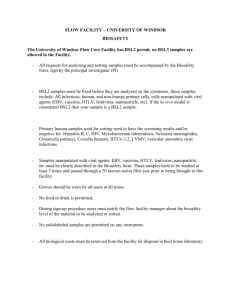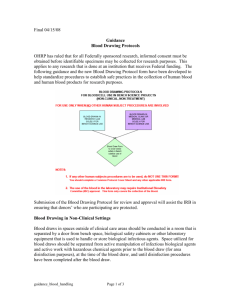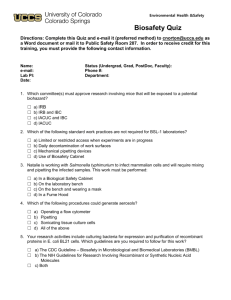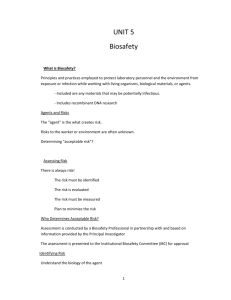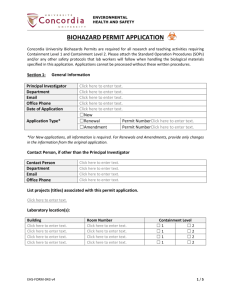Lab Specific Biosafety Manual
advertisement
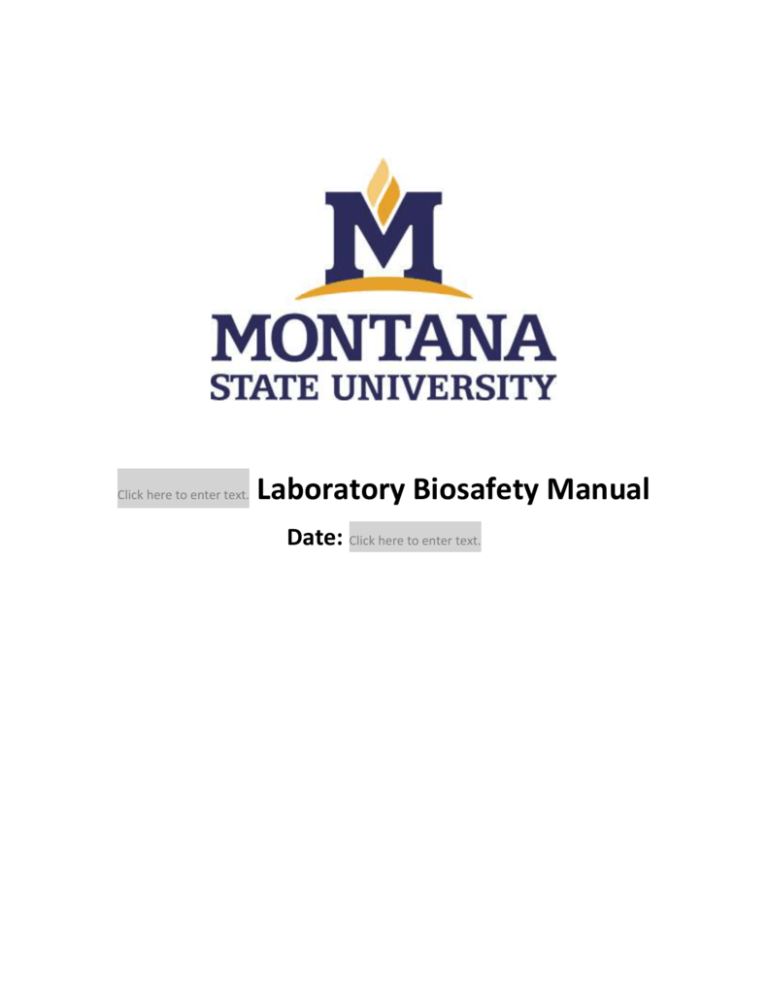
Click here to enter text. Laboratory Biosafety Manual Date: Click here to enter text. PI's Last Name Laboratory Building(s) and room number(s) Note: This template is provided to assist Principal Investigators (PIs) in the development of a laboratory-specific biosafety manual with instructions to safely handle and manipulate a particular agent or agents under laboratory conditions. The PI is responsible for including basic background information for each agent, writing an exposure risk, detailing surface decontamination, and writing standard operating procedures for experiments where safety is a concern. Also, please provide lab-specific information where you see gray text fields. Training dates should be maintained in the provided table. Additions/changes to this template that will render the final manual more useful for the laboratory’s safety needs are encouraged. If any laboratory determines the need to deviate from standard BSL2 work practices discussed in this manual, then these alterations along with a written explanation must be submitted to the Biosafety Officer for approval. In addition to this manual, the National Institutes of Health (NIH) and the MSU Institutional Biosafety Committee (IBC) require the lab to follow BSL procedures as outlined in Biosafety in Microbiological and Biomedical Laboratories, 5th Edition (http://www.cdc.gov/biosafety/publications/bmbl5/). For research involving recombinant DNA, the lab must also follow the NIH Guidelines for Research Involving Recombinant DNA Molecules (http://oba.od.nih.gov/oba/rac/Guidelines/NIH_Guidelines.htm). A loose-leaf binder that can easily accommodate changes or new materials is the recommended means for maintaining and organizing this laboratory-specific Biosafety Level 2 Manual. All lab personnel must read the contents of this manual and sign & date below. By signing this page, lab personnel agree to abide by the safety precautions and procedures discussed herein. I have read, understand, and agree to adhere to the biosafety procedures contained within: Principal Investigator: Typed Name First, Last Title Principal Investigator Signature Date Job/Student Title Enter info Enter info Enter info Enter info Enter info Enter info Enter info Enter info Enter info Enter info Enter info Enter info Enter info Enter info Enter info Enter info Signature Date Laboratory Staff: Typed Name First, Last First, Last First, Last First, Last First, Last First, Last First, Last First, Last First, Last First, Last First, Last First, Last First, Last First, Last First, Last First, Last Table of Contents Responsibilities ...................................................................................................................................................................... 4 Principal Investigator Responsibilities ............................................................................................................................... 4 Laboratory Staff/Student Responsibilities ........................................................................................................................ 4 General Emergency Information ......................................................................................................................................... 4 Emergency Contacts ........................................................................................................................................................... 4 Fire Alarms/Extinguishers .................................................................................................................................................. 5 Eyewashes .......................................................................................................................................................................... 5 Biological Spill Kit ............................................................................................................................................................... 5 Standard Operating Procedures .......................................................................................................................................... 5 Biological Spills in the Laboratory ..................................................................................................................................... 5 Small Spill Decontamination and Clean Up (less than 1 liter): ..................................................................................... 6 Large Spill (greater than 1 liter): .................................................................................................................................... 6 Biological Waste Disposal .................................................................................................................................................. 7 Liquid Biohazardous Waste Disposal: ............................................................................................................................ 7 Solid Biohazardous Waste Disposal: .............................................................................................................................. 7 Sharp Biohazardous Waste Disposal: ............................................................................................................................ 8 Injury to an individual in the laboratory ........................................................................................................................... 8 SOPs for Dr. Last name Laboratory when using BSL2 Agents ........................................................................................... 8 Inactivation and Surface Decontamination ........................................................................................................................ 8 Training ................................................................................................................................................................................. 9 Personal Protective Equipment ........................................................................................................................................... 9 Exposure Risk...................................................................................................................................................................... 10 Biohazard Warning Signs and Posting ............................................................................................................................. 10 Biological Safety Cabinets (BSC’s) .................................................................................................................................... 10 Agent(S) Specific Pathogen Safety Data Sheets................................................................................................................ 10 Responsibilities Principal Investigator Responsibilities Dr. Click here to enter text. has the primary responsibility for ensuring that their laboratory is safe. Dr. Click here to enter text. is responsible for the safe use of biological materials used in the lab. In addition, Dr. Click here to enter text. is responsible for the following: Limit personnel, student, and visitor exposure to hazards to the lowest practical level. Be familiar with the required medical surveillance for each type of biological agent used in the laboratory. Develop a written lab specific safety procedures and train personnel on them. Maintain documentation of training. Provide Personal Protective Equipment (PPE) and instruction on proper use. Ensure waste is properly disposed. Report spills, exposures or incidents to Kirk Lubick, Biosafety Officer, at 994-6998. Laboratory Staff/Student Responsibilities Knowledge of the biological agents and procedures used in the laboratory. Follow approved lab procedures and safety guidelines. Know emergency procedures. Complete all required training before conducting any lab activity. Report any unsafe conditions to the PI and/or the Biosafety Officer. Utilize appropriate lab equipment and containment facilities. General Emergency Information Emergency Contacts Principal Investigator: Lab Location: Office Phone: Cell Phone: Secondary Contact Office Phone: Cell Phone: Biosafety Officer Office Phone: Cell Phone: IBC Protocol #(s): IACUC Protocol #(s) (if applicable): First, Last Lab Location Office Phone Enter number First, Last Office Phone Enter number Kirk Lubick 994-6998 406-539-8914 Enter number(s) Enter number(s) If there is an emergency, call 2121 to reach MSU police. If there is a fire or explosion that you cannot control, evacuate the area immediately. Pull the fire alarm and then call 2121 from a safe location. If any emergency or significant spill/exposure occurs in the laboratory, immediately notify the Biosafety Officer and your lab supervisor/PI. Fire Alarms/Extinguishers Locations of fire pull station alarms: Click here to enter text. Location of fire extinguishers: Click here to enter text. Know the location of each of these, and identify the location of the extinguisher closest to your lab bench. If the fire alarm sounds, leave the building immediately and move away to a safe distance. Eyewashes Location of eyewashes: Click here to enter text. In case of exposure, proceed to nearest eyewash station. Hold eyelids open with thumb and forefinger and rinse for at least 15 minutes. Wash from outside edges towards the inside to prevent washing back into the eye. Rinse should be aimed at the inner corner of the eye (near the nose) not directly at the eyeball. “Roll” eyes around and up and down to ensure full rinsing. Contact lenses (if worn) should be removed as soon as possible. Have another member of the lab call for emergency response immediately. The area around the eye wash station must remain clear at all times. Biological Spill Kit Location of spill kit: Click here to enter text. Standard Operating Procedures Standard Microbiological Practices Standard Microbiological Practices refer to the safe laboratory work practices for working with biological agents. Hygiene and Housekeeping Keep work areas clean and uncluttered to reduce the chance of cross-contamination and inadvertent exposure to biohazards. To avoid ingestion of contaminated material, use a mechanical pipetting device, keep food out of refrigerators and microwaves in work areas, eat, drink, or apply cosmetics only in designated “clean” areas outside the laboratory. a. Wash hands after removing gloves, before leaving the lab, and when handling materials known or suspected to be contaminated. b. Clean work surfaces and decontaminate with Click here to enter text. at the end of each day. c. Remove gloves before leaving the lab, touching the face, keyboards, or control panels, and before using the elevator. Personal Protective Equipment a. Wear gloves if skin on the hand is broken, if rash is present, and when handling biological waste. b. Remove rings or other jewelry that could puncture gloves. c. Wear the appropriate glove for the hazard. Usually a type of latex or nitrile glove is recommended for working with biological material. d. Avoid reusing gloves unless they can be decontaminated. e. Wear eyewear approved for UV light or other rays that could damage eyes. Biological Spills in the Laboratory Call the Biosafety Officer when a significant spill occurs. A lab incident report form must be filled out for significant spills. A significant spill is defined as: Spills greater than 5 ml outside primary containment Spills that result in an exposure Spills that present an inhalation hazard Spills that cannot be easily cleaned Spills that endanger people or the environment Location of spill kit: Click here to enter text. Small Spill Decontamination and Clean Up (less than 1 liter): a. Stop work and secure all items you are working with. b. Replace any contaminated personal protective equipment (PPE). c. Make sure you are wearing the appropriate PPE such as disposable gloves, lab coat and eye protection (safety glasses or goggles). d. Using the Lab Spill Kit take the absorbent pads and place over the spill area. e. Make a fresh solution of 10 % bleach and pour over the absorbent pads. The absorbent pads absorb the spill, help contain the 10 % bleach solution and help prevent splattering. f. Let the bleach solution inactivate and decontaminate the biological material for a minimum of 15 minutes. g. Report the spill to Dr. Click here to enter text. and the Biosafety Officer at x6998. This is very important as the University maintains an ongoing log/list of spills and injuries as applicable and reports these as required under the NIH Guidelines for Research Involving Recombinant DNA Molecules. h. Soak up and clean up the excess bleach solution and decontaminated material with extra absorbent pads or paper towels. i. Dispose of in biohazard bag. Large Spill (greater than 1 liter): a. Stop work immediately, secure all items and avoid inhaling airborne aerosols. b. Notify others to leave the room immediately. c. Label the area off-limits for at least 30 minutes. This allows the ventilation system to purge the air. d. Remove contaminated PPE and or clothing, turn exposed clothing inward, and put in autoclave bag or biohazardous bag. e. Wash all exposed skin with soap and water. f. Report the spill to Dr. Click here to enter text. and the Biosafety Officer at x6998. This is very important as the University maintains an ongoing log/list of spills and injuries as applicable and reports these as required under the NIH Guidelines for Research Involving Recombinant DNA Molecules. g. After at least 30 minutes, Biosafety personnel will enter the area to clean up the spill. Biological Waste Disposal Liquid Biohazardous Waste Disposal: All liquid biological waste from the lab must be treated prior to disposal. Examples of biological waste include cell lines, recombinant DNA, recombinant proteins, and biological agents. The procedures below outline the steps to take to treat liquid biohazardous waste generated in Dr. Click here to enter text. lab: a. Always wear appropriate PPE such as disposable gloves, lab coat and eye protection (safety glasses or goggles) when working with biohazardous waste. b. When liquid biohazardous waste is anticipated to be generated, add 100 ml of undiluted bleach into a 1 l beaker. c. As experiments are performed and completed pour the biological waste into the beaker with the bleach. d. Once experiments are complete and if the beaker is less than 1 L add water to bring the volume to 1 L. e. Once the beaker is full the bleach has been diluted to a 10 % solution. f. Let 10 % bleach and biological waste solution stand for at least 1 hour. g. Dispose of the solution with care to avoid splatter down the lab sink and rinse beaker. Solid Biohazardous Waste Disposal: The procedures below outline the steps to take to treat solid biohazardous waste generated in Dr. Click here to enter text. lab: a. All solid lab waste that has come in contact with biological waste from the lab must be treated prior to disposal. Examples of biological waste include used personal protective equipment such as disposable gloves, paper towels, pipette tips, disposable Petri dishes, pipettes, and culture flasks. b. Always wear appropriate PPE such as disposable gloves, lab coat, and eye protection (safety glasses or goggles) when working with biohazardous waste. c. Place all potentially contaminated items in biohazardous waste bag. d. Once the bag is ¾ full close bag and place autoclave tape on the bag. e. Take the biohazard bag to the autoclave room per your buildings transportation guidelines as follows Click here to enter text. and place in the autoclave. f. Complete autoclave log book entry and autoclave biohazardous waste for Click here to enter text. following manufactures’ recommendations for autoclave operation. g. Once the autoclave cycle is complete the load within has been sterilized if the autoclave tape has turned color and the autoclave display shows no errors. h. Place the biohazardous bag into a black garbage bag prior to disposing of the waste in the dumpster. i. If the autoclave tape did not turn color and/or the autoclave display indicates errors occurred during operation or an incomplete cycle the load has not been sterilized. Notify Click here to enter text. at Click here to enter text. as the load is still considered biohazardous. Sharp Biohazardous Waste Disposal: The procedures below outline the steps to carefully handle sharps in Dr. Click here to enter text. lab: a. All used sharps must be immediately discarded into a sharps container. a. Sharps containers must be kept upright and never reach into a sharps disposal container. b. Sharps containers must be easily located in the immediate area where sharps are used. b. When sharps waste has reached the pre-marked “fill-line” of the sharps container close and lock lid. c. Contact Safety and Risk Management to have sharps containers picked-up and replaced. Injury to an individual in the laboratory (i.e. needles stick, cut, biological/chemical exposure incident – splash, etc.): a. b. c. d. Immediately stop work and flush affected area with soap and water for 15 minutes. If the injury is a Medical Emergency call 911 or campus police x2121. Secure all infectious materials. Notify Dr. Click here to enter text. and Biosafety Officer at (406) 994-6998 or Campus police x2121 after working hours. This is a very important as the University maintains an ongoing log/list of spills and injuries and as applicable reports these as required under the NIH Guidelines for Research Involving Recombinant DNA Molecules. e. Use the nearest First Aid Kit located in the laboratory. f. If during working hours seek medical attention at the Montana Occupational Health (2075 Charlotte St. Suite 3; Bozeman MT). After working hours seek medical attention at the Bozeman Deaconess Hospital Emergency Room (915 Highland Blvd; Bozeman, MT) g. Dr. Click here to enter text. will complete the Workers Compensation Injury/Incident Report form documenting the route of exposure and the circumstances under which the incident occurred. SOPs for Dr. Last name Laboratory when using BSL2 Agents The purpose of this section is to develop SOPs that specifically outline instances during protocols where consideration for safety with a BSL2 agent is paramount. Detailed, step-by step protocols describing entire experiments with materials and methods are not necessary. Examples of SOPs where safety is emphasized are bulleted below: Propagation of viruses Experiments that require PPE in addition to a lab coat and gloves Experiments that require manipulation of a BSL2 agent outside a biosafety cabinet How to properly vortex or sonicate a viable BSL2 agent Safety concerning the handling of human or non-human primate cell lines or tissues Safety when injecting a research animal with a BSL2 agent How to safely centrifuge a sample containing BSL2 agents Please enter SOPs under separate headings. Click here to enter text. Inactivation and Surface Decontamination Describe the reagents and/or processes used to inactivate the agents(s) and the method to decontaminate surfaces. Click here to enter text. Training All laboratory research personnel must take institutional provided training. Training must be documented (electronic or paper). Personnel should not initiate research until training is completed. Copies of completed training certificates should be included in this manual. Lab Personnel Relevant Training Dates CITIBloodborne Pathogens Name CITIBiosafety Initial CITIBiosafety Refresher CITI- rDNA CITI-Animal Research CITIHuman Subjects Dangerous Goods Shipping First, Last First, Last First, Last First, Last First, Last First, Last First, Last First, Last First, Last First, Last First, Last First, Last First, Last First, Last Agent(s)-specific Training. Laboratory personnel are not allowed to work with agent(s) until they have been trained by the PI who supervises their work, or a designated technical expert. The worker should demonstrate good microbiological skills and an understanding of this SOP prior to being permitted to work with agent(s). Personal Protective Equipment The following PPE must be worn when working with agent(s): Please check appropriate boxes by double clicking and selecting “checked.” Gloves Latex Nitrile Safety glasses Face shield Lab coat N95 Respirator Surgical mask Hair net Shoe covers Medical scrubs Exposure Risk Describe the means by which laboratory personnel could be exposed to the agent(s). Include practices that pose potential for exposure, such as those that could create aerosols. Click here to enter text. Biohazard Warning Signs and Posting Each laboratory must clearly display a sign that provides safety information to visitors and service personnel. ORC/SRM will provide the signs. a. All areas and laboratories which contain biohazardous agents must be posted with a biohazard sign. b. The sign must have information regarding biosafety level, materials used, entry requirements, exit requirements, emergency contact name and phone number. Biological Safety Cabinets (BSC’s) There is no requirement for directional inward airflow in a BSL-1 or BSL-2 laboratory, except as may be required for chemical odor control. BSC’s should be positioned in the laboratory away from normal traffic patterns to minimized airflow disruption. Some work may be done on the open bench by persons wearing appropriate protective clothing or gear. Any work that may produce splatters or aerosols of infectious materials should be done inside a biological safety cabinet (BSC). Before materials are introduced into the BSC, they should be wiped with disinfectant to remove any external contaminants. Clean materials should be kept to one side of the work surface, dirty items on the other. Management of workflow within the BSC is crucial to preventing cross-contamination. Rapid air movement outside the cabinet (caused by co-workers walking past, air supply vents directed across the face of the BSC, etc.) will interrupt the rather fragile air curtain, which may cause air-borne contaminants in the cabinet to be drawn into the lap of the worker. The chair should be adjusted so that the lower portion of the sash is even with the worker’s armpits. Any paper or plastic materials introduced into the BSC should not be allowed to interfere with air flow through the front or rear grilles. The downward airflow from the supply filter “splits” about one third of the way into the cabinet; in the front third, air moves to the front grille, with the remainder of the air flowing to the rear. This means that aerosol-generating activities should be performed towards the rear of the cabinet to provide further worker protection. Agent(s) Specific Pathogen Safety Data Sheets Pathogen Safety Data Sheets can be found at the Public Health Agency of Canada website (http://www.phacaspc.gc.ca/lab-bio/res/psds-ftss/index-eng.php) Attached are the Pathogen Safety Data Sheets for each Biological Agent used in Dr. Click here to enter text. Laboratory. Click here to enter text.

